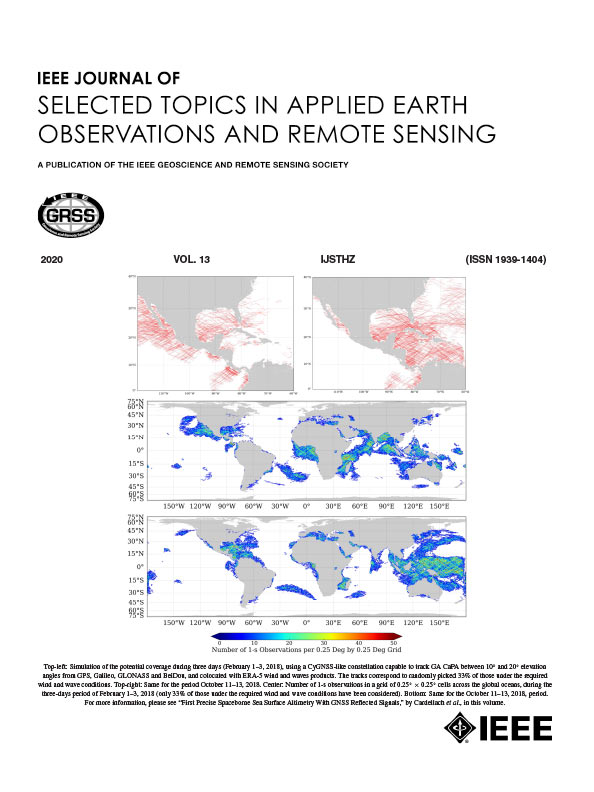面向棉花水肥管理的星-无人机遥感影像与地声信号实时多源融合与处理
IF 5.3
2区 地球科学
Q1 ENGINEERING, ELECTRICAL & ELECTRONIC
IEEE Journal of Selected Topics in Applied Earth Observations and Remote Sensing
Pub Date : 2025-08-22
DOI:10.1109/JSTARS.2025.3601798
引用次数: 0
摘要
棉花是世界上最重要的经济作物之一,有效的水肥管理对优化棉花产量和水肥利用效率尤为重要。遥感技术和多源数据的实时处理为棉花水肥状况的精准监测提供了创新的解决方案:通过卫星遥感从宏观角度观察棉花生长,结合实时传输的超声信号数据对棉花干旱胁迫进行监测,可以快速识别水肥异常;对于归一化植被指数(NDVI)相似区域,采用无人机高光谱数据与地面气象站实时监测数据同步融合,通过纹理特征分析冠层结构变化。此外,基于声学监测设备动态采集作物干旱胁迫声信号,实时提取与水相关的幅频能量等声学特征。通过对多源异构数据的实时协同处理,实现了从冠层到根区水肥状况的动态诊断,为不同肥力期的最佳水肥管理提供决策支持。通过设置不同的水肥梯度试验,综合分析了产量、水肥利用率与多源参数之间的相关规律。结果表明,NDVI和对比度在植物状态监测中具有重要的应用潜力,而基于地面声信号的作物水分状态监测也显示出广阔的应用前景。本文章由计算机程序翻译,如有差异,请以英文原文为准。
Real-Time Multisource Fusion and Processing of Satellite–UAV Remote Sensing Images and Ground Acoustic Signals for Cotton Water and Fertilizer Management
Cotton is one of the most important economic crops in the world, and effective water and fertilizer management is particularly important to optimize cotton yield and water and fertilizer use efficiency. Remote sensing technology and real-time processing of multisource data provide innovative solutions for accurate monitoring of cotton water and fertilizer status: through satellite remote sensing to observe cotton growth from a macroscopic point of view, combined with real-time transmission of ultrasonic signal data of cotton drought stress, water and fertilizer anomalies can be quickly identified; for the normalized vegetation index (NDVI)-similar areas, the simultaneous fusion of drone hyperspectral data and real-time monitoring data from ground meteorological stations is used to analyze changes in canopy structure through texture features. In addition, crop drought stress acoustic signals are dynamically collected based on acoustic monitoring equipment, and water-related acoustic features, such as amplitude–frequency–energy, are extracted in real time. This real-time synergistic processing of heterogeneous data from multiple sources achieves dynamic diagnosis of water and fertilizer status from the canopy to the root zone, and provides decision support for optimal water and fertilizer management at different fertility periods. By setting up different water and fertilizer gradient experiments, we comprehensively analyzed the correlation patterns between yield, water and fertilizer utilization, and multisource parameters. The results show that NDVI and contrast have significant application potential in plant status monitoring, while crop water status monitoring based on ground acoustic signals also shows a broad application prospect.
求助全文
通过发布文献求助,成功后即可免费获取论文全文。
去求助
来源期刊
CiteScore
9.30
自引率
10.90%
发文量
563
审稿时长
4.7 months
期刊介绍:
The IEEE Journal of Selected Topics in Applied Earth Observations and Remote Sensing addresses the growing field of applications in Earth observations and remote sensing, and also provides a venue for the rapidly expanding special issues that are being sponsored by the IEEE Geosciences and Remote Sensing Society. The journal draws upon the experience of the highly successful “IEEE Transactions on Geoscience and Remote Sensing” and provide a complementary medium for the wide range of topics in applied earth observations. The ‘Applications’ areas encompasses the societal benefit areas of the Global Earth Observations Systems of Systems (GEOSS) program. Through deliberations over two years, ministers from 50 countries agreed to identify nine areas where Earth observation could positively impact the quality of life and health of their respective countries. Some of these are areas not traditionally addressed in the IEEE context. These include biodiversity, health and climate. Yet it is the skill sets of IEEE members, in areas such as observations, communications, computers, signal processing, standards and ocean engineering, that form the technical underpinnings of GEOSS. Thus, the Journal attracts a broad range of interests that serves both present members in new ways and expands the IEEE visibility into new areas.

 求助内容:
求助内容: 应助结果提醒方式:
应助结果提醒方式:


